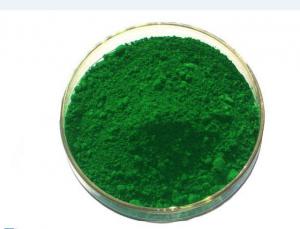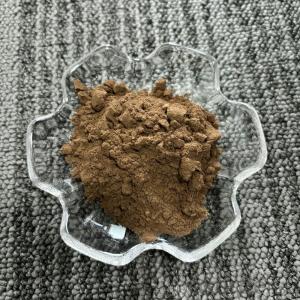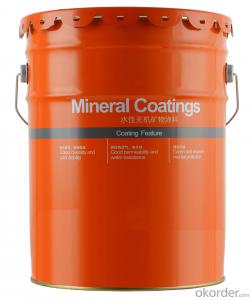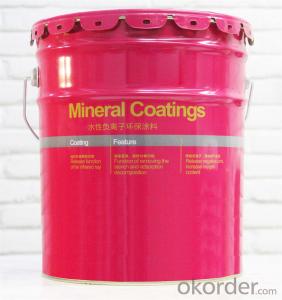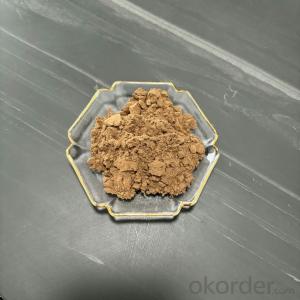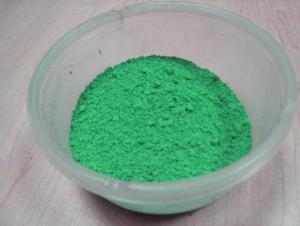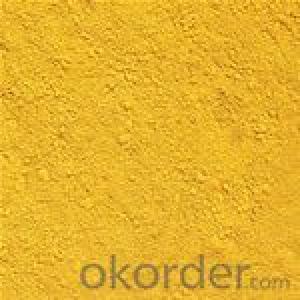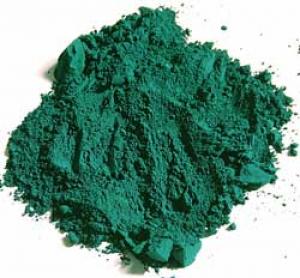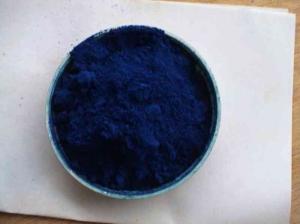Inorganic Green Pigments Chrome Oxide Green
- Loading Port:
- Shanghai Port
- Payment Terms:
- TT or LC
- Min Order Qty:
- 1 Metric Ton m.t.
- Supply Capability:
- 8000MT Per Year m.t./month
OKorder Service Pledge
OKorder Financial Service
You Might Also Like
Production Details of Chrome Oxide Green
Molecular Formula: Cr2O3
HS Code: 2819900000
CAS No. : 1308-38-9
Appearance: green powder
Specifications: (Quality Standard: HG/T 2775-1996)
Packing Of Chrome Oxide Powder :
25 kg/bag , Or 220kg / drum , or as your requirements .
Usage Of Chrome Oxide Powder :
Mainly used in paint, glass, ceramics, building materials colorants, printing ink, metal polishing, smelting metal chromium, fire-proof material, etc.
Pigment Grade:
Item | Index | ||
Excellent Grade | First Grade | Qualified Grade | |
Appearance | Green Power | ||
Color Reference | Same | ||
Relative Color Strength | Strength | ||
Density g/cm3 | 4.8 | ||
Cr2O3 | ≥ 99.0% | ≥ 98.0% | ≥ 97.0% |
Cr+6 ppm | ≤ 5 | ||
Soluble Chrome | ≤ 0.03% | ≤ 0.03% | ≤ 0.03% |
105°C Volatile Matter | ≤ 0.3% | ≤ 0.3% | ≤ 0.3% |
Water Soluble | ≤ 0.1% | ≤ 0.4% | ≤ 0.7% |
Moisture | ≤ 0.15% | ≤ 0.3% | ≤ 0.5% |
PH of Water Solution | 7—7.5 | ||
Oil Absorption (g/ 100g) | 17 | ||
Residue on Sieve of 0.045 mm | ≤ 0.1% | ≤ 0.3% | ≤ 0.5% |
1200℃ Ingition Decerement | 0.05 | ||
Acid& Alkali Resistance | 5 | ||
Temperature Stability | 1000 | ||
Weather Fastness | 5 | ||

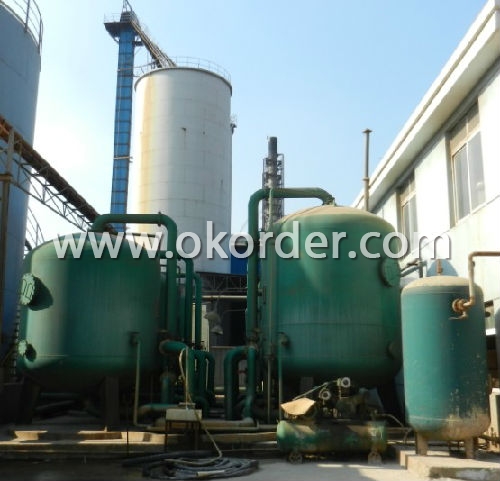

- Q:What pigments take part in photosynthesis?
- There are three basic classes of pigments. Chlorophylls are greenish pigments which contain a porphyrin ring. This is a stable ring-shaped molecule around which electrons are free to migrate. Because the electrons move freely, the ring has the potential to gain or lose electrons easily, and thus the potential to provide energized electrons to other molecules. This is the fundamental process by which chlorophyll captures the energy of sunlight. There are several kinds of chlorophyll, the most important being chlorophyll a. This is the molecule which makes photosynthesis possible, by passing its energized electrons on to molecules which will manufacture sugars. All plants, algae, and cyanobacteria which photosynthesize contain chlorophyll a. A second kind of chlorophyll is chlorophyll b, which occurs only in green algae and in the plants. A third form of chlorophyll which is common is (not surprisingly) called chlorophyll c, and is found only in the photosynthetic members of the Chromista as well as the dinoflagellates. The differences between the chlorophylls of these major groups was one of the first clues that they were not as closely related as previously thought.....
- Q:what are accessory pigments?
- Accessory pigments are light-absorbing compounds, found in photosynthetic organisms, that work in conjunction with chlorophyll a. They include other forms of this pigment, such as chlorophyll b in green algal and higher plant , while other algae may contain chlorophyll c or d. In addition, there are many non-chlorophyll accessory pigments, such as carotenoids or phycobiliproteins which also absorb light and transfer that light energy to photosystem chlorophyll. Some of these accessory pigments, particularly the carotenoids, also serve to absorb and dissipate excess light energy, or work as antioxidants. The different chlorophyll and non-chlorophyll pigments associated with the photosystems all have different absorption spectra, either because the spectra of the different chlorophyll pigments are modified by their local protein environment, or because the accessory pigments have intrinsic structural differences. The result is that, in vivo a composite absorption spectrum of all these pigments is broadened and flattened such that a wider range of visible and infrared radiation is absorbed by plants and algae. Most photosynthetic organisms do not absorb green light well, thus most remaining light under leaf canopies in forests or under water with abundant plankton is green, a spectral effect called the green window. Organisms such as some cyanobacteria and red algae contain accessory phycobiliproteins that absorb green light reaching these habitats. For more kindly click on the links below --- en.wikipedia.org/wiki/Accessory_p... en.wikipedia.org/wiki/Photosynthe...
- Q:Please and thank you, it doesn't say so on the website.
- Mac Pigment Ingredients
- Q:what is the pigment in hibiscus?
- Hibiscus flowers bear pigments of three types: carotenoids, anthocyanins, and flavonols. The exact pigments (all three of those types are actually sizeable families of similar chemicals) and the exact proportions depend on the color of the particular flower: there are literally several hundred species in the genus Hibiscus, and they come in all shades of red, pink, yellow, and orange. Carotenoids are oil-soluble, fairly stable pigments that come in all shades of red, orange, and yellow. Anthocyanins are water-soluble and significantly less stable: they're responsible for the blues, pinks, purples, and reds, and in high concentrations can produce colors so dark as to look black. Flavonols are the least vivid of the pigments: they produce pale pastel yellows, cream colors, and off-whites. (Plain white flowers usually have no visible pigment at all.) Flavonols actually do most of their color absorption in the UV spectrum: they're the plant equivalent of the melanin in human skin, keeping them from getting sunburnt.
- Q:Compare and contrast pigment color with the color seen from a light. What is the difference between mixing pigment colors and mixing light colors?
- Pigments are chemicals that selectively absorb and reflect different spectra of light. When a surface is painted with a pigment, light hitting the surface is reflected, minus some wavelengths. This subtraction of wavelengths produces the appearance of different colors. Most paints are a blend of several chemical pigments, intended to produce a reflection of a given color. Mixing pigments is subtractive. Mixing light is additive. Let's take the primary pigments, red, blue and yellow. Red pigment is red because the chemical it is made of absorbs (subtracts) blue and yellow light that falls on it and reflects only red light to your eye. Similarly, blue pigment is blue because it absorbs red and yellow light and reflects only blue. So when you mix the three primary pigments together, you produce something that absorbs all of the light falling on it in equal amounts and reflects nothing to your eye. Thus, it appears black. In contrast, when you mix only red and blue light, there isn't any yellow in it, so the resulting light appears purple (the complement of yellow). Likewise, if you mix red and yellow light it appears orange (the complement of blue). If you mix all three colors of light together (in equal amounts), the resulting light appears white because it contains all of the colors of the spectrum. This explanation is sound, although greatly simplified. The two summaries above are not my own, nor do I claim them as mine.
- Q:I hear about it cause my Friend is albino and she was born with no pigments in her hair,skin or eyes
- then she is natural coz she is not using any substances to colour or paint....
- Q:does photosythesis requier pigment moulecuels?
- Pigments are needed, because they absorb the energy from the light. Different chlorophylls absorb different wavelengths. When pigment absorbs the photon, it releases an electron, which is used in photosynthesis as energy. Without pigment the light would just past through or reflect and no energy would be left to the cell to be turned into sugar.
- Q:what is pigment?
- In biology, a pigment is any material resulting in color of plant or animal cells. Many biological structures, such as skin, eyes, fur and hair contain pigments (such as melanin) in specialized cells called chromatophores. Many conditions affect the levels or nature of pigments in plant and animal cells. For instance, Albinism is a disorder affecting the level of melanin production in animals. Pigment color differs from structural colour in that it is the same for all viewing angles, whereas structural color is the result of selective reflection or iridescence, usually because of multilayer structures. For example, butterfly wings typically contain structural color, although many butterflies have cells that contain pigment as well.
- Q:I hear about it cause my Friend is albino and she was born with no pigments in her hair,skin or eyes
- then she is natural coz she is not using any substances to colour or paint....
- Q:a. chlorophyll ab. chlorophyll bc. chlorophyll cd. carotenoid pigments
- Chlorophylls are greenish pigments which contain a porphyrin ring. This is a stable ring-shaped molecule around which electrons are free to migrate. Because the electrons move freely, the ring has the potential to gain or lose electrons easily, and thus the potential to provide energized electrons to other molecules. This is the fundamental process by which chlorophyll captures the energy of sunlight. There are several kinds of chlorophyll, the most important being chlorophyll a. This is the molecule which makes photosynthesis possible, by passing its energized electrons on to molecules which will manufacture sugars. All plants, algae, and cyanobacteria which photosynthesize contain chlorophyll a. A second kind of chlorophyll is chlorophyll b, which occurs only in green algae and in the plants. A third form of chlorophyll which is common is (not surprisingly) called chlorophyll c, and is found only in the photosynthetic members of the Chromista as well as the dinoflagellates. The differences between the chlorophylls of these major groups was one of the first clues that they were not as closely related as previously thought. Carotenoids are usually red, orange, or yellow pigments, and include the familiar compound carotene, which gives carrots their color. These compounds are composed of two small six-carbon rings connected by a chain of carbon atoms. As a result, they do not dissolve in water, and must be attached to membranes within the cell. Carotenoids cannot transfer sunlight energy directly to the photosynthetic pathway, but must pass their absorbed energy to chlorophyll. For this reason, they are called accessory pigments. One very visible accessory pigment is fucoxanthin the brown pigment which colors kelps and other brown algae as well as the diatoms. From this I would say the answer is c.
1. Manufacturer Overview |
|
|---|---|
| Location | Shandong, China |
| Year Established | 2007 |
| Annual Output Value | Above US$ 10 Million |
| Main Markets | Southeast Asia; Middle East; Oceania; South Asia; Western Europe; Southern Europe; Middle East; East Asia |
| Company Certifications | ISO9001:2000 |
2. Manufacturer Certificates |
|
|---|---|
| a) Certification Name | |
| Range | |
| Reference | |
| Validity Period | |
3. Manufacturer Capability |
|
|---|---|
| a)Trade Capacity | |
| Nearest Port | Qingdao Port, China |
| Export Percentage | 41-50% |
| No.of Employees in Trade Department | 5-10 People |
| Language Spoken: | English; Chinese; |
| b)Factory Information | |
| Factory Size: | Above 30,000 square meters |
| No. of Production Lines | Above 6 |
| Contract Manufacturing | Design Service Offered; Buyer Label Offered |
| Product Price Range | High; Average |
Send your message to us
Inorganic Green Pigments Chrome Oxide Green
- Loading Port:
- Shanghai Port
- Payment Terms:
- TT or LC
- Min Order Qty:
- 1 Metric Ton m.t.
- Supply Capability:
- 8000MT Per Year m.t./month
OKorder Service Pledge
OKorder Financial Service
Similar products
New products
Hot products
Related keywords
